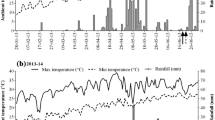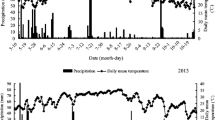Abstract
Soil organic matter, roots (photosynthates) and applied organic materials (rice straw etc.) are the main sources of methane (CH4) emitted from paddy fields. The potential CH4 production in Japanese paddy fields were estimated from chemical properties of paddy soils of respective soil series, their acreage and thermal regimes during the rice growing period. The estimated amounts of potential CH4 production were from 24 to 54 kg-C ha-1 among 7 Districts in Japan, which are around one fifth of the amounts of CH4 emission observed from paddy fields in the world.
13CO2 uptake pot experiments were carried out three times from Aug. 8 to Sept. 25 to the treatment without rice straw applications in 1993 and four times from June 30 to Sept. 13 to the treatments with and without rice straw applications in 1994 to estimate the contribution of photosynthesized carbon to CH4 emission. The contribution percentages of photosynthesized carbon to the total CH4 emitted to the atmosphere were calculated to be 22% and 29-39% for the entire growth period in the treatments with and without rice straw applications, respectively.
The relationship between the amount of CH4 emission to the atmosphere from submerged paddy soils with rice plants and the application level (0-8 g kg-1) of rice straw in soil was investigated in a pot experiment. The increase (Y) in cumulative amounts of CH4 with the increase in the application level of rice straw was formulated with a logistic curve: Y=k[a/(1 +be-cx)]; x, application level of rice straw; k, a coefficient for relative CH4 emission. Since the seasonal variations in coefficients a, b and c in the equation were also formulated as the function of the sum of effective temperature (E, Σ (T-15); T, daily average temperature), Y from any paddy soil by any level of rice straw application was known to be estimated by the equation: Y=k[a(E)/(1 +b(E)e-c(E)x)].
Similar content being viewed by others
References
Bouwman AF (1990) Exchange of greenhouse gases between terrestrial ecosystems and the atmosphere. In: Bouwman AF (ed) Soils and Greenhouse Effect, pp 61–127. John Wiley and Sons Ltd, New York, USA
Charles WL & Bollich PK (1993) Methane emissions from Louisiana first and ratoon crop rice. Soil Sci 156: 42–47
Cicerone RJ, Delwiche CC, Tyler SC & Zimmerman PZ (1992) Methane emissions from California rice paddies with varied treatments. Global Biogeochem Cycles 6: 233–248
Cicerone RJ & Shetter JD (1981) Sources of atmospheric methane: measurement in rice paddies and a discussion. J Geophys Res 86: 7203–7209
Dei Y & Yamazaki S (1979) Effect of water and crop management on the nitrogen-supplying capacity of paddy soils. In: Nitrogen and Rice, pp 451–463. International Rice Research Institute, Los Banos, Laguna, Phillipines
Holzapfel-Pschorn A, Conrad R & Seiler W (1986) Effects of vegetation on the emission of methane from submerged paddy soil. Plant Soil 92: 223–233
Inubushi K & Wada H (1988) Mineralization of carbon and nitrogen in chloroform-fumigated paddy soil under submerged conditions. Soil Sci Plant Nutr 34: 287–291
Kimura M, Ando H & Haraguchi H (1991a) Estimation of potential CO2 and CH4 production in Japanese paddy fields. Environ Sci 4: 15–25
Kimura M, Miura Y, Watanabe A, Katoh T & Haraguchi H (1991b) Methane emission from paddy field (Part 1). Effect of fertilization, growth stage and midsummmer drainage: Pot experiment: Environ Sci 4: 265–271
Kimura M, Murakami H & Wada H (1991c) CO2, H2 and CH4 production in rice rhizosphere. Soil Sci Plant Nutr 37: 55–60
Minoda T & Kimura M (1994) Contribution of photosynthesized carbon to the methane emitted fron paddy fields. Geophys Res Lett 21: 2007–2010
Murase J, Kimura M & Kuwatsuka S (1993) Methane production and its fate in paddy fields. III. Effects of percolation on methane flux distribution to the atmosphere and the subsoil. Soil Sci Plant Nutr 39: 63–70
Oda K, Miwa E & Iwamoto A (1987) Compact data base for soil analysis data in Japan. Jpn J Soil Sci Plant Nutr 58: 112–131
Sass RL, Fisher FM & Harcombe PA (1990) Methane production and emission in a Texas rice field. Global Biogeochem Cycles 4: 47–68
Sass RL, Fisher FM & Harcombe PA (1991) Mitigation of methane emissions from rice fields: Possible adverse effects of incorporated rice straw. Global Biogeochem Cycles 5: 275–287
Schütz H, Holzapfel-Pschorn A, Conrad R, Rennenberg H & Seiler W (1989) A 3-year record on the influence of daytime, season, and fertilizer treatment on methane emission rates from an Italian rice paddy. J Geophys Res 94: 16405–16416
Statistics and Information Department (1977) Sakumotsu tokei No. 19 (Crop production statistics. No. 19), Economics Affairs Bureau, Ministry of Agriculture, Forestry and Fisheries, Japan, Norin Tokei Kyokai, Tokyo (In Japanese)
Sugimoto A, Hong X & Wada E (1991) Rapid and simple measurement of carbon isotopic ratio of bubble methane using GC/C/IRMS. Mass Spectrosc 39: 261–266
Takai Y (1961) Reduction and microbial metabolism in paddy soils (3). Nogyo Gijutsu (Agricultural Technology). 16: 122–126 (In Japanese)
Watanabe A, Katoh Y & Kimura M (1993) Effect of rice straw application on CH4 emission from paddy fields. I. Effect of weathering of rice straw in the field during off-crop season. Soil Sci Plant Nutr 39: 701–706
Watanabe A, Katoh Y & Kimura M (1994) Effect of rice straw application on CH4 emission from paddy fields. III. Effect of incorporation site of rice straw on CH4 emission rates and their variation among shoots of a rice plant. Soil Sci Plant Nutr 40: 497–504
Watanabe A, Satoh Y & Kimura M (1995) Estimation of the increase in CH4 emissions from paddy soils by rice straw application. Plant Soil 173: 225–231
Yagi K & Minami K (1990) Effect of organic matter application on methane emission from some Japanese paddy fields, Soil Sci Plant Nutr 36: 599–610
Yoshino T & Dei Y (1977) Prediction of nitrogen release in paddy soils by means of the concept effective temperature. J Cent Agric Exp Stn 25: 1–62 (In Japanese)
Author information
Authors and Affiliations
Rights and permissions
About this article
Cite this article
Kimura, M. Sources of methane emitted from paddy fields. Nutrient Cycling in Agroecosystems 49, 153–161 (1997). https://doi.org/10.1023/A:1009790920271
Issue Date:
DOI: https://doi.org/10.1023/A:1009790920271




